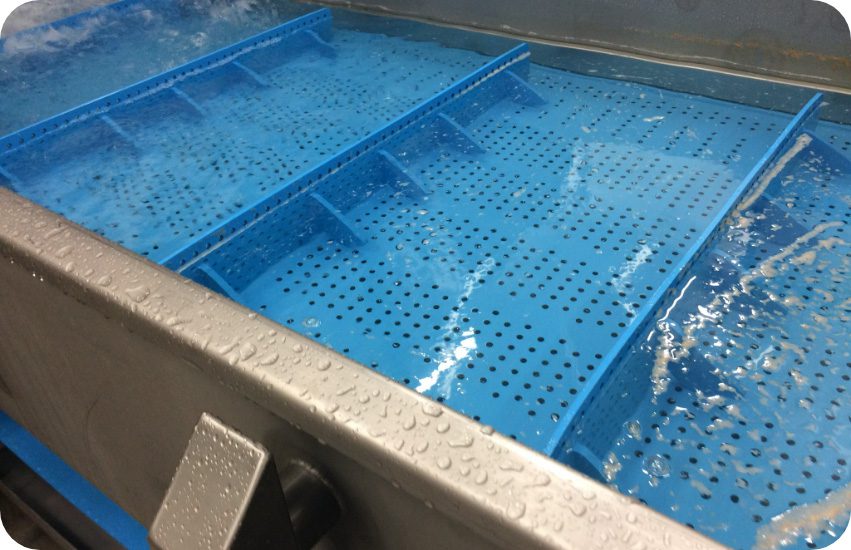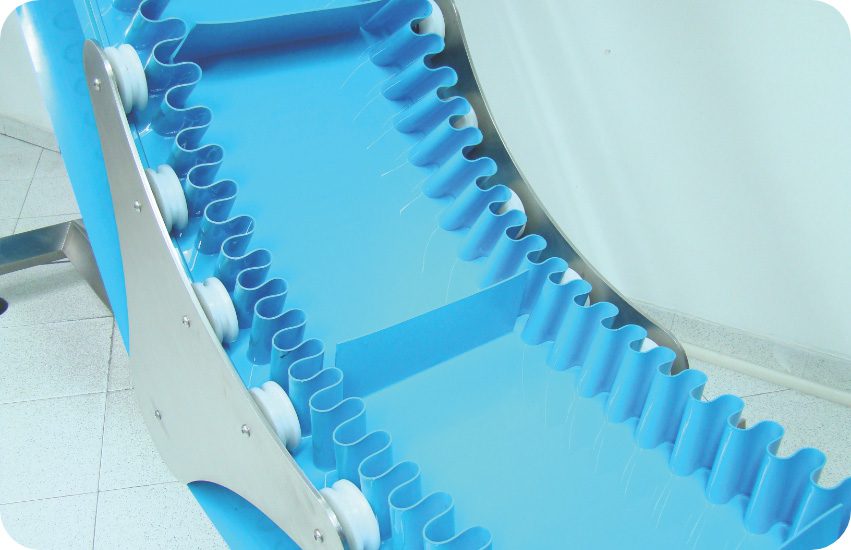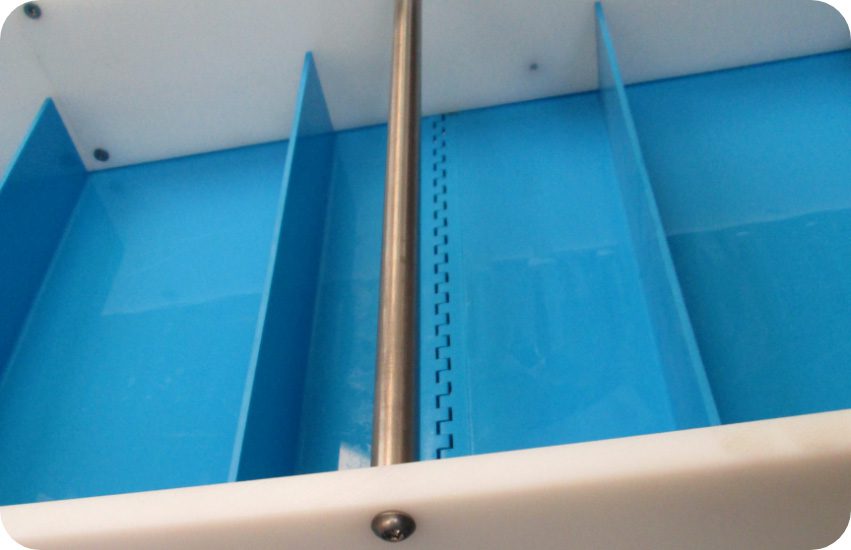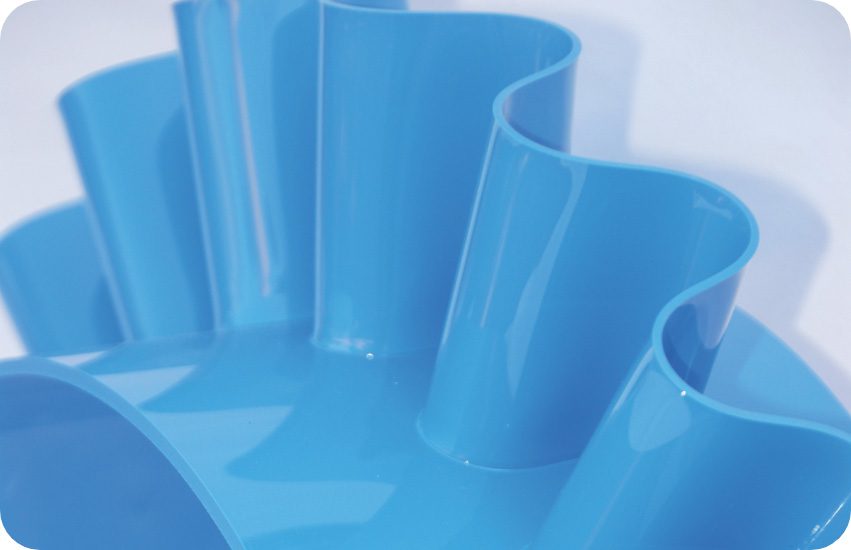Home » Solutions par type de convoyeur
Conveyor belt selection is a deductive process which must first address the production and engineering criteria of the user. The demands of the customer relate to the expected load on the belt, hourly throughput, orientation, or position of the conveyor in the production room and the dimensions and features of the conveyor that limit belt choice, such as Minimum Pulley Diameter. These criteria are what dictate belt choice in the given conditions.
Once the above criteria are defined, the items being conveyed should be matched up with the correct belt type. The characteristics of the product being transported impacts the belt choice. Varying textures on the carrying surface of the belt may assist movement depending on product type such as berries or granules moving on a moderate inclined angle. The product may have acidic content that is not suited to certain belt types, where chemical degradation will quickly crack the belt surface. Similarly, exposure to UV may mean a darker belt is a better choice.
Horizontal conveyors are the most basic and widely used conveyor style in the market. They are used on assembly lines, small parts handling, food processing and integrated inside more sophisticated machinery to give increased throughput. They have fewer limitations than other conveyor types in terms of dimensions, speeds, load, and space required. They can be suited to accumulation or telescopic applications. Much of the same can be said for simple two-axle conveyors when used on a slight incline. They can function well depending on the angle, product type and flow rate.








Elevators using cleated or sidewall conveyor belts are an accepted solution for transferring products from one height to another. They can be used to elevate or lower a product down, as in an IQ freezer outfeed. Elevators can have one inclined section or additional horizontal sections that require the belt to ‘transition’ from one orientation to another. Elevators can be simple two-axle conveyors, or they can have one horizontal section (L-shaped) or two horizontal sections (Z, swan-neck, or goose-neck).
Centre drives are most common on horizontal conveyors. This style is used where a processor looks for advantages such as saved distance between conveyors, dual direction, and tight transfer. The belt path on a standard two-axle conveyor, with a drive pulley at one end is simple but does not always fulfill the customers’ needs. One additional option is the center drive. This involves positioning the motor beneath the conveyor with the tensioner located on the same axle beneath the conveyor. This design is also critical where small diameter rollers are located at both ends of the conveyor. The rollers may not be large enough to motorize and may even be static ‘nose bars’ used extensively in bakeries. The motor in these cases must be on a third axle.








Trough conveyors are commonly used on transfer lines, small parts handling, and food processing. They share most of the design characteristics of two-axle conveyors but with the additional raised edges to contain the product on the belt. This feature requires belts to be flexible and to maintain their shape over the pulleys and on the return. They are often used on incline conveyors to hygienically contain the product. Care is always required to ensure that the infeed of a product onto the belt is suited to the demands of the processor and the capacity of the conveyor. It is imperative the product is contained on the belt and does not fall under and inside the belt path.
When you are looking for the ideal solution to help you increase your production rate, simplify the process, slash costs and comply with regulations, it’s time for SuperDrive™!
A Positive Drive belt that solves the key mechanical problems of classic flat belts, namely, slipping and off-tracking, SuperDrive™ helps lower running costs for reduced cost of ownership, requires less hot water, provides less chemical exposure, and reduces cleaning time.
As a result, you have more time and money for production. Perfect!
Dough pump conveyors are used to process raw dough in large-scale production bakeries.
These conveyors elevate dough at a sharp incline and commonly use plied belts with bottom guides. Due to uneven loads, bakery belts often suffer from off-tracking, and slippage, which can cause fraying, tearing and the need for belt tension, leading to belt failure. A retrofit to
SuperDrive™ solves all of that, making raw dough production… as easy as pie.
Bakery lines often incorporate small pulley diameters and static ‘knife edge’ nose bars. When selecting the right belt for your business, make sure to measure the diameter/radius and, to note the wrapping angle.
Our bakery conveyor belts are specifically tailored for biscuit and pizza base cutting lines, helping make dough production simple and efficient.
Our TPE bakery conveyor belts are highly resistant to cuts and abrasion.
They are also easily repaired in the event of mechanical damage, making them robust, cost-effective, and literally, the best thing since sliced bread.
Ethical standards guide our business practices, reflecting our commitment to fairness, trust, and reliability. We value mutual respect, intellectual honesty, and humility.Each team member takes ownership of
their decisions and pursues continuous improvement. This philosophy builds enduring relationships that highlight our long-term success.
Despite our global reach, we maintain individuality in all interactions, cultivating strong relationships.
with customers, partners, and colleagues. Our approach ensures everyone feels valued and supported. We promote work-life balance through a family-oriented culture, creating an environment that fosters both individual and collective growth.
We encourage employees to take initiative, make decisions, and drive innovation by providing necessary resources. This culture of accountability enables our team to excel and contribute to the company’s progress. We nurture our employees’ potential through an inclusive environment, offering constructive feedback and recognition. Our commitment extends to self-actualization, helping staff find career fulfillment while advancing organizational goals.

Success at Volta is a collective endeavor. Our motto, « We are in it together; we will act as one, » embodies our commitment to unity and mutual support. We provide an environment of belonging and open communication. By harnessing each employee’s unique talents, we overcome challenges together as a team, making us stronger together than the sum of our parts.
Our stakeholders benefit from efficient, reliable, and high-performance belting products.
Our industry-leading expertise enables our customers and partners to stay ‘one step ahead’ while we support their sustainable growth. Our continuous investment in training and knowledge retention ensures innovative thinking and cutting-edge solutions designed to keep our customers at the forefront of their industries.
We prioritize our customers’ unique needs and challenges, offering tailored solutions to ensure their success. Our commitment drives continuous improvement of our products and services. We maintain a strategic Go-to-Market (GTM) mindset and a can-do approach, always aiming to innovate. Our emphasis on quality and customer-oriented solutions encourages mutual benefit and lasting partnerships.